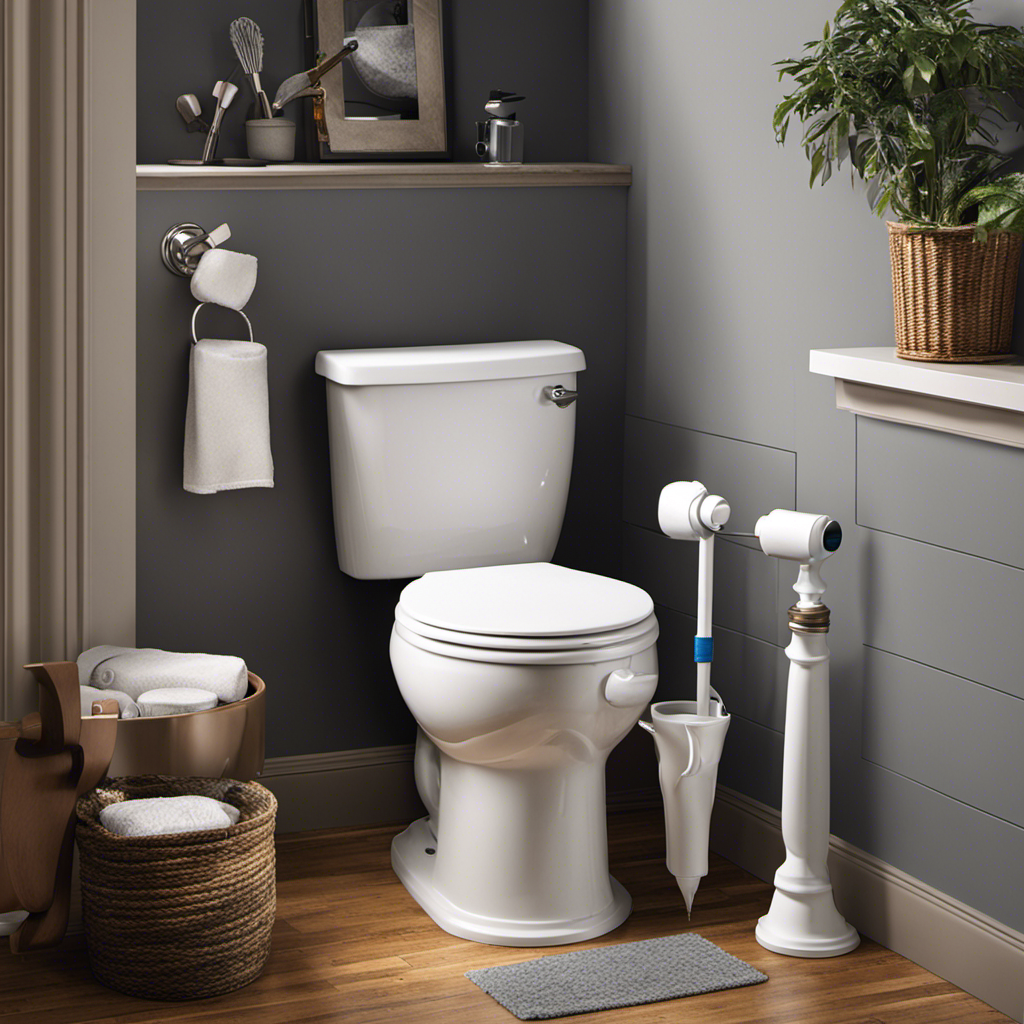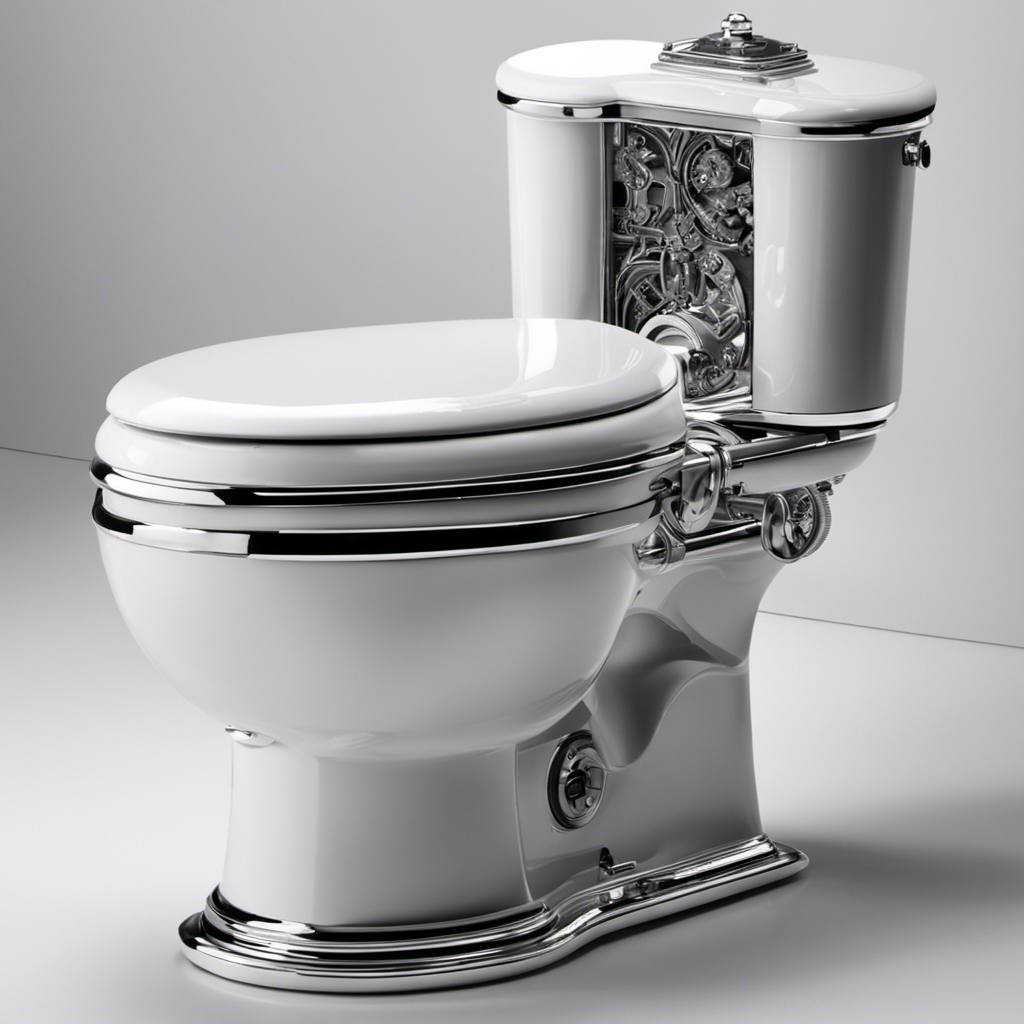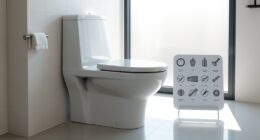Hey there! Ever had that sinking feeling when your toilet starts to overflow? Trust me, I’ve been there too. But fear not, because in this article, I’m going to share with you some practical tips and tricks on how to stop toilet overflow.
From common causes and signs to the step-by-step guide for clearing a clogged toilet, we’ve got you covered. So grab your tools and supplies, and let’s dive into the world of preventing and troubleshooting toilet overflows.
Let’s keep those bathroom emergencies at bay!
Key Takeaways
- Clogged drain and flushing non-flushable items are common causes of toilet overflow.
- Warning signs of toilet overflow include slow drainage, gurgling noises, high water levels, rising water level after flushing, foul odors, and bubbling in other drains.
- Preventing toilet overflow involves regular maintenance, responsible usage, and installing an overflow prevention device.
- Immediate action steps to take when toilet starts overflowing include shutting off water supply, checking and sealing the flapper valve, using a plunger, and calling a professional if needed.
Common Causes of Toilet Overflow
One of the most common causes of toilet overflow is a clogged drain. When the drain is blocked, water cannot flow freely, resulting in an overflow.
It is important to understand that prevention is key when it comes to avoiding toilet overflow. Regular maintenance and proper usage can help prevent this issue.
One common toilet problem that can lead to a clogged drain is flushing excessive amounts of toilet paper or disposing of non-flushable items such as wipes or feminine hygiene products. These can accumulate and create a blockage in the drain pipe.
To prevent toilet overflow, it is essential to only flush toilet paper and waste. Avoid flushing anything else, and consider using a plunger or a drain snake to clear any minor clogs.
Proper maintenance and responsible usage can help keep your toilet functioning properly and prevent overflow.
Signs of an Impending Toilet Overflow
So, you want to avoid the nightmare of a toilet overflow? Well, there are some warning signs you should keep an eye out for. These include slow drainage, gurgling noises, and water levels rising higher than usual.
To prevent a potential overflow, it’s important to regularly maintain your toilet. This can be done by avoiding flushing excessive toilet paper or foreign objects and by keeping an eye on the water levels.
However, if you do find yourself in a sticky situation, there are immediate action steps you can take to minimize the damage. First, turn off the water supply valve to stop the flow of water. Then, use a plunger to try and unclog the toilet.
Warning Signs to Watch for
If your toilet is making strange gurgling sounds or draining slowly, you might be experiencing warning signs of a potential overflow. It’s important to identify these signs early to prevent any major damage or inconvenience. Here are some warning signs to look out for:
- Water rising to the rim: If you notice the water level rising close to the rim after flushing, it’s a clear indication of a potential overflow.
- Slow draining: If your toilet is taking longer than usual to drain, it could be due to a blockage that can lead to an overflow.
- Gurgling sounds: Unusual gurgling sounds coming from the toilet bowl can be a sign of a clog or obstruction in the pipes.
- Foul odors: Persistent foul smells emanating from the toilet can indicate a blockage causing wastewater to back up.
- Bubbling in other drains: If you notice bubbling or gurgling in sinks or showers when using the toilet, it could be a sign of an impending overflow.
To prevent a toilet overflow, here are some essential tips:
- Regular maintenance: Schedule regular inspections and maintenance to catch any potential issues before they escalate.
- Avoid flushing non-flushable items: Never flush items like wipes, sanitary products, or cotton balls down the toilet, as they can cause clogs.
- Use less toilet paper: Excessive toilet paper can also cause blockages, so use only what is necessary.
- Install a toilet overflow alarm: Consider installing an alarm system that can alert you when the water level in the toilet is rising dangerously.
- Call a professional: If you’re experiencing any warning signs or are unsure of how to handle a potential overflow, it’s best to call a professional plumber for assistance.
Preventing Toilet Overflow
Regular maintenance and proper disposal of non-flushable items can help prevent potential issues with your toilet. To avoid toilet overflow, it’s important to understand the causes and implement prevention techniques.
One common cause of toilet overflow is a clogged drain pipe. This can occur when items such as paper towels, feminine hygiene products, or excessive toilet paper are flushed down the toilet. To prevent this, only flush toilet paper and waste.
Additionally, regular maintenance includes checking the water level in the tank and adjusting the fill valve if necessary. It’s also crucial to inspect the flapper and replace it if it’s worn out.
Lastly, consider installing an overflow prevention device that automatically shuts off the water supply if the water level rises too high.
Immediate Action Steps
To prevent potential issues, it’s crucial to take immediate action steps when dealing with a toilet overflow. Here are some quick fixes and steps to prevent overflow that you can take:
-
Shut off the water supply: Locate the shut-off valve near the base of the toilet and turn it clockwise to stop the flow of water.
-
Remove the tank lid: Lift the lid and place it in a safe spot to prevent any damage.
-
Check the flapper valve: Ensure that the flapper valve is properly sealed and not stuck open. If it is, gently push it down to stop the water flow.
-
Use a plunger: If the water level rises rapidly, use a plunger to create pressure and dislodge any clogs.
-
Call a professional: If the overflow persists or you are unsure of what to do, it’s best to call a plumber for assistance.
By taking these immediate action steps, you can minimize damage and prevent further overflow issues.
Now, let’s move on to the next section to learn about the steps to take when your toilet starts overflowing.
Steps to Take When Your Toilet Starts Overflowing
When your toilet starts overflowing, it’s important to take immediate action to prevent any further damage.
In this discussion, I will provide you with practical steps to quickly address the issue and minimize the mess.
Additionally, I will share some preventive measures to help you avoid future toilet overflows.
Immediate Action for Overflowing
Quickly shut off the water supply to prevent further toilet overflow.
In case of an emergency response situation like a toilet overflow, it is crucial to take immediate action to minimize damage and ensure the safety of your home. Here are some containment measures you can take:
- Turn off the water supply valve located behind or near the toilet.
- Remove any items or obstacles near the overflowing toilet to prevent them from getting wet or damaged.
- Use towels or rags to soak up the excess water on the bathroom floor.
- If the water level continues to rise, use a bucket or a large container to manually remove some of the water from the toilet bowl.
- Open windows or turn on fans to promote ventilation and help dry out the area.
Preventing Future Toilet Overflow
After dealing with an immediate toilet overflow, it’s crucial to take steps to prevent future incidents.
Toilet overflow prevention starts with identifying and addressing common toilet problems. One common issue is a clogged toilet, which can be caused by excessive use of toilet paper or the flushing of non-flushable items. To avoid this, use toilet paper in moderation and dispose of items like wipes and feminine hygiene products in the trash.
Another common problem is a faulty flapper valve, which can lead to continuous running water and potential overflow. Regularly inspect the flapper valve and replace it if necessary. Additionally, make sure the water level in the tank is set correctly to prevent overflow.
Tools and Supplies You’ll Need to Stop a Toilet Overflow
To stop a toilet overflow, you’ll need a plunger and a bucket. Here are some tools and supplies that can help you troubleshoot the problem:
-
Plunger: This is the most essential tool for clearing a clog. Make sure it has a good seal against the drain.
-
Bucket: Use a bucket to collect any excess water from the toilet bowl before plunging.
-
Rubber gloves: Protect your hands from any potential mess.
-
Towels or rags: These can be used to clean up any spills or drips.
-
Snake or auger: If the plunger doesn’t work, a snake or auger can help break up stubborn clogs.
Having these tools and supplies on hand will make it easier for you to tackle a toilet overflow.
Now, let’s move on to the step-by-step guide to clearing a clogged toilet.
Step-by-Step Guide to Clearing a Clogged Toilet
First, assess the severity of the clog to determine the best course of action. If the water level is not too high, try using plunging techniques with a flanged plunger. Place the plunger over the drain hole, push down firmly, and pull up quickly. Repeat until the water starts to drain.
If the clog is stubborn or the water level is too high, it’s time to seek professional help. A plumber will have the necessary tools and expertise to clear the clog effectively.
Preventive Measures to Avoid Toilet Overflow
Now that you know how to clear a clogged toilet, let’s talk about preventive measures to avoid toilet overflow. Taking these steps can save you from the hassle and mess of dealing with a flooded bathroom.
Here are some practical tips for toilet overflow prevention:
-
Regular maintenance: Inspect your toilet regularly for any signs of leaks or clogs. Fixing these issues promptly can prevent overflow.
-
Proper flushing: Teach everyone in your household to flush only toilet paper and waste. Avoid flushing items like baby wipes, cotton balls, or sanitary products that can clog the toilet.
-
Adjust water level: Check the water level in the tank and adjust it if necessary. Too much water can lead to overflow, while too little can cause weak flushes.
-
Install a water alarm: Consider installing a water alarm near the toilet. It will alert you if there is a sudden increase in water level, giving you time to address the issue before it overflows.
-
Professional inspection: If you frequently experience toilet overflow or suspect a larger plumbing issue, it’s best to consult a professional plumber to troubleshoot and fix the problem.
Troubleshooting Tips for Persistent Toilet Overflows
If you’re experiencing persistent toilet overflows, try adjusting the water level in the tank. Sometimes, the water level may be set too high, causing the toilet to overflow. To adjust the water level, locate the fill valve on the left side of the tank and turn the adjustment screw clockwise to lower the water level. This should help prevent future overflows. However, if the problem continues, there may be other underlying causes that need to be addressed.
Here are some common causes and preventive measures for persistent toilet overflows:
| Causes | Prevention |
|---|---|
| Clogged drain | Regularly clean the drain and avoid flushing non-flushable items. |
| Faulty fill valve | Replace the fill valve if it is malfunctioning or not shutting off properly. |
| Blocked vent pipe | Clear any blockage in the vent pipe to ensure proper air flow. |
| Worn-out flapper | Replace the flapper if it is worn out or not creating a proper seal. |
| Sewer line issues | Check for any sewer line clogs or problems and address them promptly. |
Conclusion
In conclusion, preventing a toilet overflow is like taming a wild river. Just as a skilled river guide anticipates the twists and turns of the water, we must also be proactive in maintaining our toilets.
By identifying common causes, recognizing warning signs, and taking immediate action, we can navigate this potential disaster with ease. Armed with the right tools and knowledge, we can clear clogs and prevent future overflows.
Remember, a well-maintained toilet is like a calm river flowing smoothly, bringing peace and tranquility to your bathroom.










